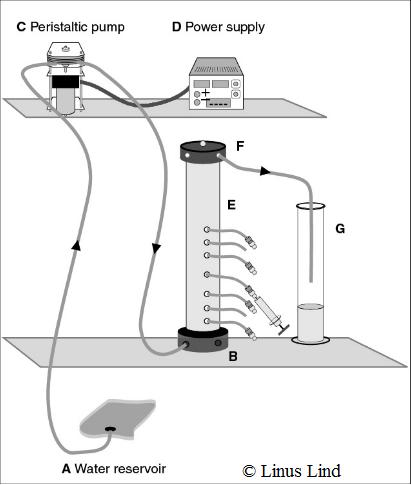Experimental setup

We collected intact soil cores from four riparian wetlands next to the following streams Simested, Villestrup, Haderis and Odderbæk. The samplings were performed during 24th June until 26th September 2011.
The soil cores are approximately about 30 cm long and 6 cm in diameter, collected directly into steel cylinders. These steel cylinders was attached to a special designed iron head drill in the field which enables us to collect whole undisturbed soil cores. The same steel cylinders were used in a laboratory experimental setup, incubated under similar condition as in the field, regarding water hydrology and temperature (10°C).
Groundwater which was used in the experimental setup was collected next to the soil sampling sites. We added nitrogen solution to the groundwater and further flushed by helium. This was made in order to remove oxygen from the groundwater. The water was pumped through the soil, bottom to top. We collected 5-10 mL water samples at seven different depths (including inlet and outlet) from the soil core, during fifteen days. This water samples was analysed for greenhouse gases, nitrogen compounds and other possible regulated parameters.
It was therefore possible to simultaneously study nitrate removal capacity and production of greenhouse gases in the soil.
In order to measure soil nutrients, steel rings were pressed by hand into the soil. Six different depths between 0 to 30.5 cm below soil surface was measured for carbon and nitrogen content in soil and organic matter.
Analyse and dataprocessing
The water samples was analysed for ammonia, phosphate, nitrate, nitrite, chloride, sulfate, nitrous oxide, methane and the Isotope 29N2 and 30N2 . Each of the variables was measured three times from each depth. Each day we measured electrical conductivity, pH-level and oxygen content from inlet and outlet water. Every fifth day we measure pH-level and electrical conductivity at the seven depths.
The nitrate and nitrite removal and ammonia production capacity and greenhouse gas production was calculated from the differences in the measured concentration at the investigated depths. The area of the cylinder and the measured flow rate for the day were also taken into account. A mean value was calculated from the five days interval measurement values for each variable.
We studied the interaction between the measured variables, and their response to nutrients removal/production rate and greenhouse gas production rate in a statistical program. This was done in order to identify which parameters are more or less important for nitrate removal capacity and greenhouse gas production.
Responsible for this page:
Director of undergraduate studies Biology
Last updated:
05/02/12
